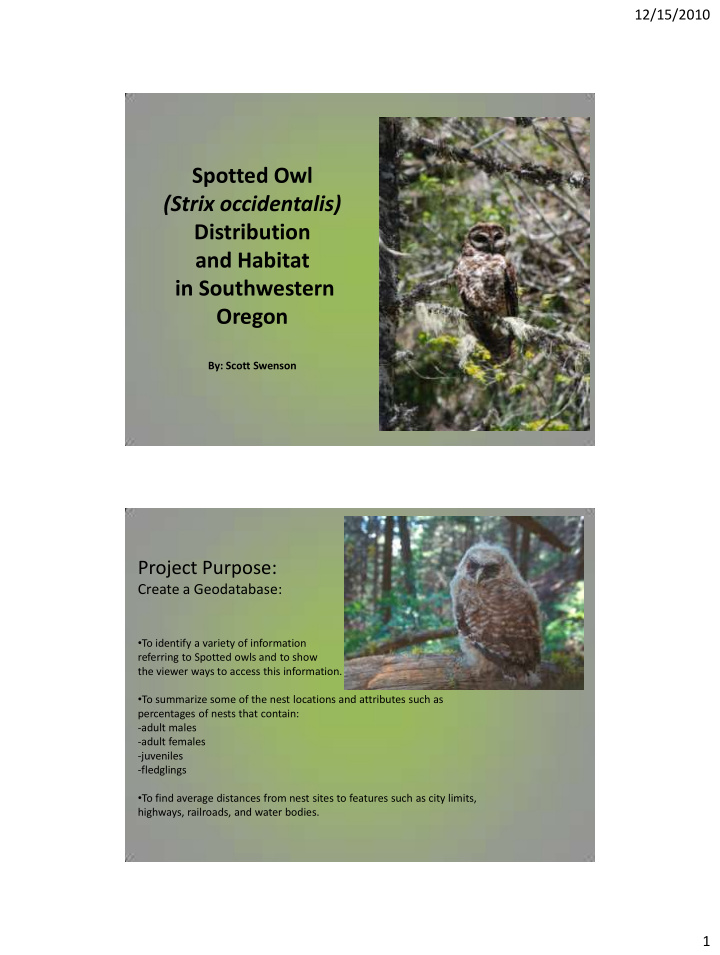



12/15/2010 Spotted Owl (Strix occidentalis) Distribution and Habitat in Southwestern Oregon By: Scott Swenson Project Purpose: Create a Geodatabase: • To identify a variety of information referring to Spotted owls and to show the viewer ways to access this information. • To summarize some of the nest locations and attributes such as percentages of nests that contain: -adult males -adult females -juveniles -fledglings • To find average distances from nest sites to features such as city limits, highways, railroads, and water bodies. 1
12/15/2010 Project Area: Distribution of Northern Spotted Owl The east/west extent is Western Oregon between National Forest land The north/south extent covers the entire state from Portland south to California Geodatabase Design 2
12/15/2010 Methods and Techniques: • Performed a number of queries to find nesting locations that fell within features such as: -city limits -late-successional habitat -land owner/management • Used query to find sex/age populations and their locations • Performed some proximity analysis by to find out the average distances from nesting sites to features such as highways, railroads, streams and water bodies, and city limits. Select By Location Examples Spotted Owl Nesting Locations in Late-Succession Habitat Out of 19,907= 58% 3
12/15/2010 Known Activity Areas Within Late-Successional Habitat 38% Known Nesting Locations Within City Limits 4
12/15/2010 Select By Attributes Examples: USFS Land Around Project Area Number of Known Nest Locations w/ Males 53% 5
12/15/2010 (Cont’d) Advanced Selection w/ “Where” clause Known Nest Locations w/ 3 Juveniles 1% 6
12/15/2010 Proximity Analysis Using “Near” Tool Examples Nesting Location Proximity to Highways Nesting Location Proximity to City Limits 7
12/15/2010 Nesting Location Proximity to Water Bodies Results: • 58% of nests are located in late-succession forests • 38% of observed owl activity has been identified in late-succession forests • # of nests w/ males = 10,726, or 53% • # of nests w/ females = 8809, or 44% • # of nests with juveniles = 2875, or 14% Query -1 juvenile = 1306, or 45% Out of 19,907 -2 juveniles = 1547, or 54% -3 juveniles = 22, or 1% nests • # of nests with fledglings = 2806, or 14% -1 fledgling = 1305, or 46% -2 fledglings = 1481, or 53% -3 fledglings = 20, or 1% Proximity Tool Nest proximity to Highways: Average = 33,041 ft (6.3 miles) Minimum = 288 ft Nest proximity to City Limits: Average = 54,819 ft (10.4 miles) Minimum = 4,694 ft Nest proximity to Water Bodies: Average = 6,502 ft (1.2 miles) Minimum = 0 ft 8
12/15/2010 Limitations: • Lack of data availability-no data on owl populations in National Forests -higher -wilderness areas elevation -hydrology -temperature -forest roads -precipitation -food sources -tree species References: • Wikipedia http://en.wikipedia.org/wiki/Northern_Spotted_ Owl • Bird Web- Seattle Audubon Society http://birdweb.org/birdweb/bird_details.aspx?id =248 • USFW http://www.fws.gov/ • The Owl Pages http://www.owlpages.com/owls.php?genus=Stri x&species=occidentalis • Spotted Owl Populations http://online.redwoods.cc.ca.us/instruct/darnold /laproj/Fall97/Asher/mike.pdf 9
Recommend
More recommend